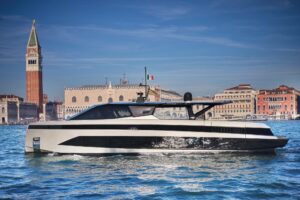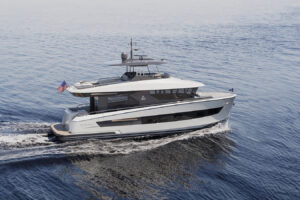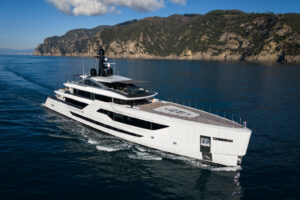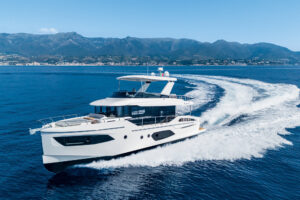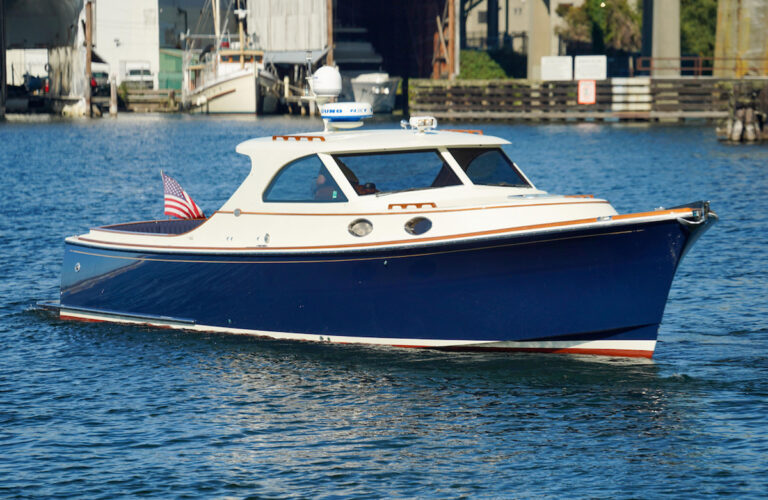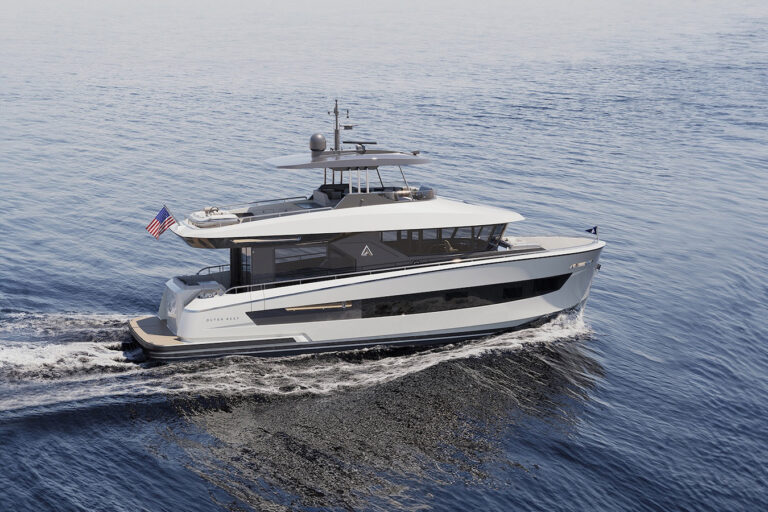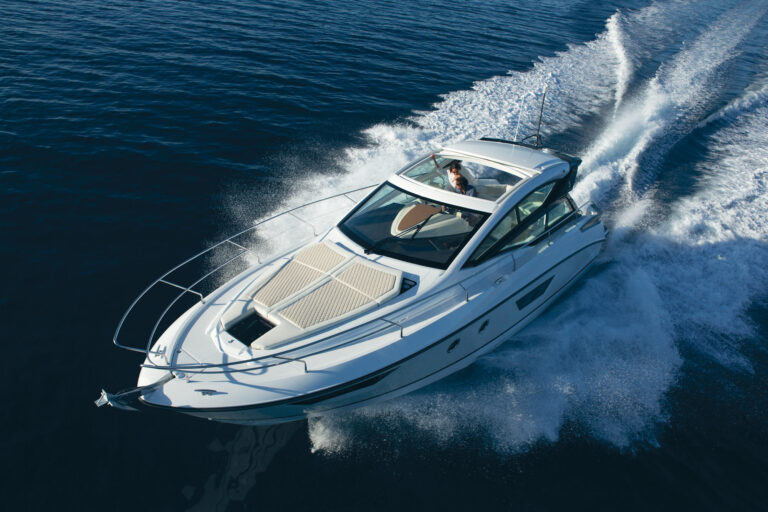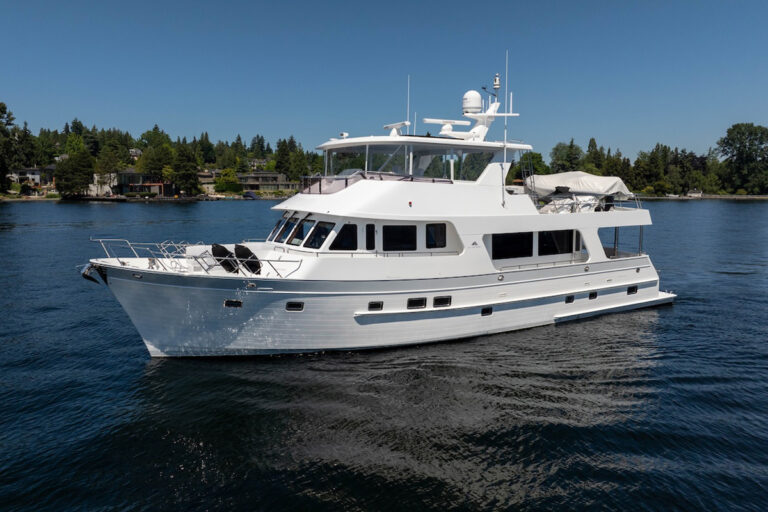The voice on the phone sounded amused by my question as to where in the marina I might find Wanderbird.
“Oh, you won’t have any problem finding her!” was the response.
The person on the phone was right. With her tall mast supporting folded booms for paravanes, twin stacks protruding from her upper deck and, most unusual for modern powerboats, roller-furling jibs on headstays, Wanderbird wasn’t hard to spot. And that is how I was introduced to this highly customized Royal Passagemaker 65 expedition motoryacht from British Columbia’s Park Isle Marine.
Wanderbird has the slightly cluttered look of a soldier headed into battle, but as with the soldier, that look is misleading, because everything has a place and a purpose. This motoryacht looks larger than her 65 feet; she is full-bodied and clearly ready to handle whatever the sea dishes out. From a floating pier, her high bulwarks make her seem immense. Wanderbird is no marina cupcake, no wannabe explorer-this is a yacht made to cross expanses of open ocean safely and luxuriously.
It’s hard to separate Wanderbird from her owner, George Baker, since they are extensions of each other.
“Twenty years of ideas, two years of engineering, and four years of building”, is how Baker wryly described the gestation of the boat. Like her name, Wanderbird is something more, too.
Baker’s grandfather, a commodore of the New York Yacht Club, was the financial backer for a trio of epic voyages by Warwick Tompkins, arguably one of the greatest seamen of all time. Tompkins cruised in the late 1930s aboard his Wander Bird, an engineless 85-foot pilot schooner, including one voyage when he and his family sailed around Cape Horn, from 50 degrees south to 50 degrees south, in 28 days.
The new Wanderbird, spelled to differentiate her from the original, was created to fulfill Baker’s longtime dream to “do the capes and follow in the historic wake of the earlier Wander Bird.
Baker considered a number of builders before settling on Park Isle Marine, a family-owned yard that has been a well-kept secret among the yachting cognoscenti. It’s the only Canadian builder using resin-infusion technology. The yard was familiar with the displacement-type hull Baker wanted, and even more important, it was willing to go the extra distance to customize Wanderbird to his exacting specifications. That the Canadian dollar was advantageous against U.S. currency was not overlooked, either.
The starting point for Wanderbird was the well-proven Seamaster hull form from Ed Monk Sr., which was refined by naval architect Gregory C. Marshall. Construction is to very sophisticated standards using Core-Cell foam, with 4-inch-thick laminations of glass at the stem and keel. Carbon-fiber structures were created to spread the compression loads from the mast. The result, while appearing classic, is actually very high-tech.
“I’ve never understood conventional layouts”, Baker said, “because the galley should never be compromised.”
Enter the saloon through the side doors and you’ll find the layout seemingly reversed. The galley is all the way aft-a door leads to the afterdeck for dockside provisioning-and the lounge area is forward, separated by a two-bench dining table.
The saloon’s décor is reminiscent of a gentleman’s yacht from a century ago, with beautifully varnished mahogany in a raised-panel design set off by painted white bulkheads. It is comfortably cozy, with down-filled cushions on the settee (which converts for formal dining with a sliding table), a plasma TV that swings down from the overhead, and an intricately shaped mahogany wet bar around the mast compression post.
Details such as the book-matched teak sole create an effect that is at once rugged and exquisitely beautiful. Brass sea rails on the bookshelves and deep leeboards on the bunks underline the thoughtfulness that marks every part of Wanderbird. She has a cheerful saltiness that is a blend of Nantucket and Northwest.
The galley is arranged so the cook can brace in a seaway, though the motion should be minimal in this location. Pass-through windows open to the afterdeck and dining area, and the galley can be closed off with pocket doors for privacy or night running. A propane stove is set in the all-white counters, and grab rails are conveniently overhead, as they are throughout the vessel.
Stairs lead to a lower foyer, with a passageway suggestive of a vintage ocean liner. The master stateroom, which spans the full beam amidships, has double sea berths to port and starboard atop painted white drawers.
Wanderbird was designed specifically for Baker and his wife to handle, so two en suite guest staterooms with crisscrossed bunks on each side of the passageway are ample for four guests on a voyage.
The pilothouse is arranged to be the all-weather heart of the yacht, with spacious chart tables, a trio of Stidd seats, a comfortable settee and, best of all, a snug pilot berth built into the after bulkhead for the off watch. Wing doors lead to the Portuguese bridge and the foredeck, which has a commercial reel windlass.
While Wanderbird has a bilge-keel displacement hull that will have a restful motion at sea, Baker decided to augment the stability with paravane flopper stoppers, which will be towed from booms that extend on each side. The sturdy mast that supports the very large paravane loads will be put to good use with a large tanbark mainsail that roller-furls neatly inside the mast when not in use. In addition, twin reacher headsails are on roller furlers and can be sheeted to the ends of the booms for running wing-and-wing. With favorable winds, Baker expects the spread of sail to add at least a knot to Wanderbird.
As with everything aboard the boat, the propulsion system was carefully planned, and Baker chose a soft-mounted Caterpillar 3408 that was detuned to produce 396 hp and great reliability. The engineroom is immense and as spotless as a surgery. The Caterpillar drives a Hundestad variable-pitch propeller that is well protected by the keel, while twin 40kW Northern Lights gensets handle the normal electrical loads. Under way, a 25kW Hydra-Gen hydraulic generator runs off the main engine, and a 4kW Trace inverter can provide overnight power.
Most dreams are frivolous affairs, but Wanderbird is a dream that came to fruition because of an owner who invested in careful planning and a boatbuilder willing to go the extra distance. That is what turns dreams into reality.
Contact: Park Isle Marine, (250) 391-6802; www.parkislemarine.com. For more information, contact: (866) 922-4877

